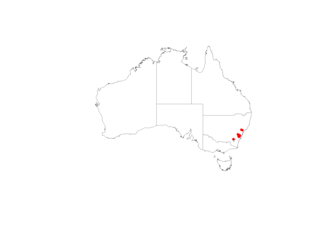
Prostanthera eurybioides, commonly known as Monarto mintbush, is a species of flowering plant in the family Lamiaceae and is endemic to the south-east of South Australia. It is a low, spreading shrub with densely hairy branches, thick, elliptic to egg-shaped leaves clustered on short shoots, and violet to mid-purple flowers that are white with orange and dark purple dots inside the petal tube.

Prostanthera nivea, commonly known as snowy mint-bush, is a species of flowering plant in the family Lamiaceae and is endemic to eastern Australia. It is a shrub with linear to cylindrical leaves and white flowers arranged in leaf axils near the ends of branchlets and is one of the mint-bushes that is not aromatic.

Prostanthera cuneata, commonly known as alpine mint bush, is a species of flowering plant in the mint family Lamiaceae, and is endemic to mountainous areas of south-eastern continental Australia. It is an erect, compact shrub with egg-shaped leaves with the narrower end towards the base, and pale lavendar to almost white flowers with purple blotches.

Prostanthera cryptandroides is a species of flowering plant in the family Lamiaceae and is endemic to eastern Australia. It is a low, spreading shrub with narrow egg-shaped leaves and lilac to mauve flowers arranged singly in leaf axils.

Prostanthera linearis, commonly known as narrow-leaved mint-bush is a species of flowering plant in the family Lamiaceae and is endemic to eastern Australia. It is an erect, faintly aromatic shrub with glabrous, narrow egg-shaped to linear leaves and white flowers that are often tinged with pinkish-mauve.

Prostanthera denticulata, commonly known as rough mint-bush, is a species of flowering plant in the family Lamiaceae and is endemic to south-eastern continental Australia. It is a straggling to almost prostrate, aromatic shrub with narrow egg-shaped leaves and purple to mauve flowers arranged in leaf axils or on the ends of branchlets.

Prostanthera incana, commonly known as velvet mint-bush, is a species of flowering plant in the family Lamiaceae and is endemic to south-eastern continental Australia. It is an erect, moderately dense shrub with egg-shaped leaves, and lilac-coloured flowers, found mostly in near-coastal southern New South Wales.

Prostanthera saxicola is a species of flowering plant in the family Lamiaceae and is endemic to eastern Australia. It is a shrub with linear to elliptic leaves and white to mauve flowers arranged in leaf axils.

Prostanthera althoferi is a species of flowering plant in the family Lamiaceae and is endemic to inland areas of Australia. It is an erect shrub with its stems and leaves densely covered with silvery, greyish-green hairs, and has narrow egg-shaped leaves and white to cream-coloured flowers with mauve or purple striations inside.

Prostanthera ammophila, commonly known as sand mintbush, is a species of flowering plant in the family Lamiaceae and is endemic to southern areas of South Australia. It is an erect to spreading shrub with egg-shaped to narrow elliptical leaves and white and purple to mauve flowers with yellow spots inside.

Prostanthera behriana, commonly known as tall mintbush, is a species of flowering plant in the family Lamiaceae and is endemic to the south-east of South Australia. It is an erect to straggling shrub with egg-shaped leaves and white, pale blue, pale violet or purplish white flowers with red-brown spots or purple streaks inside.

Prostanthera caerulea, commonly known as lilac mint bush, is a species of flowering plant that is endemic to eastern Australia. It is an erect shrub with narrow egg-shaped leaves that have toothed edges, and white to bluish mauve flowers arranged on the ends of branchlets.

Prostanthera canaliculata is a species of flowering plant in the family Lamiaceae and is endemic to the south-west of Western Australia. It is a small, erect shrub with hairy branchlets, narrow egg-shaped to narrow elliptical leaves and pale blue or pale violet to white flowers with no markings.

Prostanthera chlorantha, commonly known as green mintbush, is a species of flowering plant in the family Lamiaceae and is endemic to the south-east of South Australia. It is a small shrub with small, broadly egg-shaped to round leaves and mauve, bluish green, or greenish red to greenish yellow flowers with a pink tinge.

Prostanthera grylloana is a species of flowering plant in the family Lamiaceae and is endemic to Western Australia. It is a small, erect shrub with densely hairy branchlets, small, spatula-shaped leaves and red to pink flowers.

Prostanthera nanophylla is a species of flowering plant in the family Lamiaceae and is endemic to Western Australia. It is a small shrub with hairy branches, egg-shaped to elliptic or narrow oblong leaves and mauve or blue to white flowers with dull brown, maroon or purple spots.

Prostanthera rugosa is a species of flowering plant in the family Lamiaceae and is endemic to a restricted area of New South Wales. It is an openly-branched shrub with egg-shaped or narrow egg-shaped, thick, fleshy leaves and mauve flowers with a white tinge arranged in leaf axils near the ends of branchlets.

Prostanthera semiteres is a species of flowering plant in the family Lamiaceae and is endemic to Western Australia. It is a small shrub with narrow egg-shaped leaves with the narrower end towards the base and pink or red flowers.

Prostanthera sericea, commonly known as silky mintbush or walyuwalyu, is a species of flowering plant in the family Lamiaceae and is endemic to inland Australia. It is an erect shrub with hairy branches, cylindrical leaves and white flowers with mauve or purple streaks.

Prostanthera splendens is a species of flowering plant in the family Lamiaceae and is endemic to Western Australia. It is a small, spreading shrub with small, densely glandular, egg-shaped leaves and mauve to light purple flowers, paler on the inside with mauve to reddish-brown dots.




















